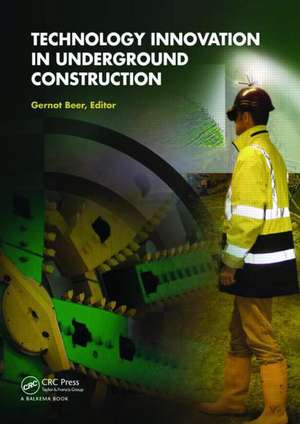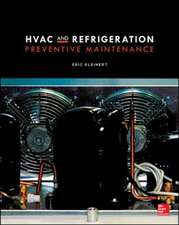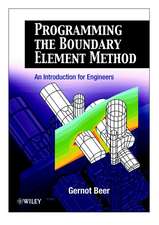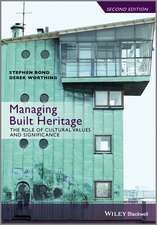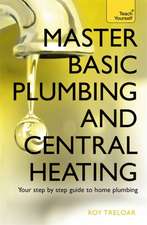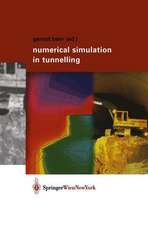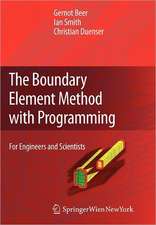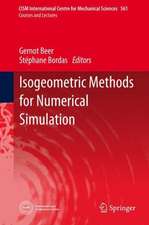Technology Innovation in Underground Construction
Editat de Gernot Beeren Limba Engleză Hardback – 16 oct 2009
A primary focus of the technological development in underground engineering is to ease the practical execution and to reduce time, cost and risk in the construction and maintenance of underground facilities such as tunnels and caverns. This can be realized by new design tools for designers, by instant data access for engineers, by virtual prototyping and training for manufacturers, and by robotic devices for maintenance and repair for operators and many more advances.
This volume presents the latest technological innovations in underground design, construction, and operation, and comprehensively discusses developments in ground improvement, simulation, process integration, safety, monitoring, environmental impact, equipment, boring and cutting, personnel training, materials, robotics and more. These new features are the result of a big research project on underground engineering, which has involved many players in the discipline.
Written in an accessible style and with a focus on applied engineering, this book is aimed at a readership of engineers, consultants, contractors, operators, researchers, manufacturers, suppliers and clients in the underground engineering business. It may moreover be used as educational material for advanced courses in tunnelling and underground construction.
Preț: 997.11 lei
Preț vechi: 1372.52 lei
-27% Nou
Puncte Express: 1496
Preț estimativ în valută:
190.79€ • 199.74$ • 157.87£
190.79€ • 199.74$ • 157.87£
Carte tipărită la comandă
Livrare economică 05-19 aprilie
Preluare comenzi: 021 569.72.76
Specificații
ISBN-13: 9780415551052
ISBN-10: 0415551056
Pagini: 528
Dimensiuni: 174 x 246 x 28 mm
Greutate: 1.02 kg
Ediția:1
Editura: CRC Press
Colecția CRC Press
ISBN-10: 0415551056
Pagini: 528
Dimensiuni: 174 x 246 x 28 mm
Greutate: 1.02 kg
Ediția:1
Editura: CRC Press
Colecția CRC Press
Public țintă
Postgraduate, Professional, Professional Practice & Development, and UndergraduateCuprins
1. Introduction 2. UCIS – Underground Construction Information System 3. Computer-support for the Design of Underground Structures 4. A Virtual Reality Visualization System for Underground Construction 5. From Laboratory, Geological and TBM Data to Input Parameters for Simulation Models 6. Process-oriented Numerical Simulation of Mechanized Tunneling 7. Computer Simulation of Conventional Construction 8. Optical Fibre Sensing Cable for Underground Settlement Monitoring During Tunneling 9. Tunnel Seismic Exploration and Its Validation Based on Data From TBM Control and Observed Geology 10. Advances in the Steering of Tunnel Boring Machines 11. Real-time Geological Mapping of the Front Face 12. Reducing the Environmental Impact of Tunnel Boring (OSCAR) 13. Safety Assessment During Construction of Shotcrete Tunnel Shells Using Micromechanical Material Models 14. Observed Segment Behaviour During Tunnel Advances 15. Optimizing Rock Cutting Through Computer Simulation 16. Innovative Roadheader Technology for Safe and Economic Tunnelling 17. Tube-à-manchette Installation Using Horizontal Directional Drilling for Soil Grouting 18. TBM Technology for Large to Very Large Tunnel Profiles 19. Real-time Monitoring of the Shotcreting Process 20. Environmentally Friendly, Customised Sprayed Concrete 21. Innovations in Shotcrete Mixes 22. High Performance and Ultra High Performance Concrete Segments – Development and Testing 23. Robotic Tunnel Inspection and Repair 24. An Innovative Geotechnical Characterization Method for Deep Exploration.
Notă biografică
Short professional biographies of all contributors are included in the back of the volume.
The editor, Gernot Beer (Graz University of Technology, Austria), is currently the head of the Institute for Structural Analysis at the University Technology, Graz Austria. His main expertise is numerical simulation and he heads a group of researchers that is developing the next generation software for the simulation of underground excavations. He has conducted research and has consulted on this topic for three decades and authored and co-authored four textbooks on this subject. Prior to coordinating the project TUNCONSTRUCT he was the coordinator of a national research initiative Simulation in Tunneling (SiTu) and of another European project (Virtual fire emergency simulation, VITRUALFIRES). The project SiTu resulted in a book “Numerical Simulation in Tunneling” published by Springer for which he was the editor. As part of his consulting activities he served, together with Prof. E.T. Brown, on a panel of experts for the investigation of the Masjed-e-Soleiman underground Hydroelectric Power Plant in Iran.
The editor, Gernot Beer (Graz University of Technology, Austria), is currently the head of the Institute for Structural Analysis at the University Technology, Graz Austria. His main expertise is numerical simulation and he heads a group of researchers that is developing the next generation software for the simulation of underground excavations. He has conducted research and has consulted on this topic for three decades and authored and co-authored four textbooks on this subject. Prior to coordinating the project TUNCONSTRUCT he was the coordinator of a national research initiative Simulation in Tunneling (SiTu) and of another European project (Virtual fire emergency simulation, VITRUALFIRES). The project SiTu resulted in a book “Numerical Simulation in Tunneling” published by Springer for which he was the editor. As part of his consulting activities he served, together with Prof. E.T. Brown, on a panel of experts for the investigation of the Masjed-e-Soleiman underground Hydroelectric Power Plant in Iran.
Recenzii
"[…] The large spectrum and depth of topics covered, and their impact on the tunnel design and construction, makes this book of particular interest for practicing engineers and for applied researchers." Prof. Giancarlo Gioda, Politecnico di Milano, Italy
"[...] the project will certainly result in a breakthrough in activities ranging from planning to maintenance. Contributions cover the whole spectrum of underground construction activities with an integrated approach." Tarcisio B. Celestino, University of Sao Paulo
"[...] the publication [...] is a major contribution to knowledge on advanced tunnelling techniques, and should also be noted by those in positions of power that still think that tunnelling is a nasty, dirty, low-tech pursuit." Maurice Jones, Tunnels & Tunnelling International August 2010
This book contains the results of one of the largest research projects on tunnels and underground openings carried out in the European Community and aims at introducing innovative design tools and new technical procedures in tunnelling engineering. Edited by Prof. Gernot Beer, one the leading authorities in the development and application of computer oriented methods in rock/soil engineering, it presents 24 contributions of leading experts in the field. Contributions span from new information systems and computer supported methods for tunnel design, to the visual representation of the progress of excavation; from software for the numerical simulation of mechanized and conventional tunnelling methods, and for monitoring of the displacements induced by tunnelling, to software for controlling the advancing process of tunnel boring machines. Other chapters concern technological problems, such as the use ofshotcrete and of low pressure injections, the optimization of rock cutting tools, the robotic inspection of tunnels, etc. The large spectrum and depth of topics covered, and their impact on the tunnel design and construction, makes this book of particular interest for practicing engineers and for applied researchers. Giancarlo Gioda, Professor of Geotechnical Engineering, Dept. of Structural Engineering, Politecnico di Milano, Italy
"[...] the project will certainly result in a breakthrough in activities ranging from planning to maintenance. Contributions cover the whole spectrum of underground construction activities with an integrated approach." Tarcisio B. Celestino, University of Sao Paulo
"[...] the project will certainly result in a breakthrough in activities ranging from planning to maintenance. Contributions cover the whole spectrum of underground construction activities with an integrated approach." Tarcisio B. Celestino, University of Sao Paulo
"[...] the publication [...] is a major contribution to knowledge on advanced tunnelling techniques, and should also be noted by those in positions of power that still think that tunnelling is a nasty, dirty, low-tech pursuit." Maurice Jones, Tunnels & Tunnelling International August 2010
This book contains the results of one of the largest research projects on tunnels and underground openings carried out in the European Community and aims at introducing innovative design tools and new technical procedures in tunnelling engineering. Edited by Prof. Gernot Beer, one the leading authorities in the development and application of computer oriented methods in rock/soil engineering, it presents 24 contributions of leading experts in the field. Contributions span from new information systems and computer supported methods for tunnel design, to the visual representation of the progress of excavation; from software for the numerical simulation of mechanized and conventional tunnelling methods, and for monitoring of the displacements induced by tunnelling, to software for controlling the advancing process of tunnel boring machines. Other chapters concern technological problems, such as the use ofshotcrete and of low pressure injections, the optimization of rock cutting tools, the robotic inspection of tunnels, etc. The large spectrum and depth of topics covered, and their impact on the tunnel design and construction, makes this book of particular interest for practicing engineers and for applied researchers. Giancarlo Gioda, Professor of Geotechnical Engineering, Dept. of Structural Engineering, Politecnico di Milano, Italy
"[...] the project will certainly result in a breakthrough in activities ranging from planning to maintenance. Contributions cover the whole spectrum of underground construction activities with an integrated approach." Tarcisio B. Celestino, University of Sao Paulo
Descriere
This richly-illustrated reference guide presents innovative techniques focused on reducing time, cost and risk in the construction and maintenance of underground facilities. It outlines new design tools for designers, and technological innovations in underground design, construction, and operation, and comprehensively discusses developments in ground improvement, simulation, process integration, safety, monitoring, environmental impact, equipment, boring and cutting, personnel training, materials, robotics and more.
Written in an accessible style and with a focus on applied engineering, this book is intended for professionals and advanced students.
Written in an accessible style and with a focus on applied engineering, this book is intended for professionals and advanced students.
